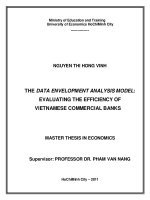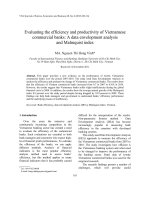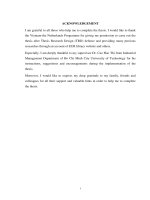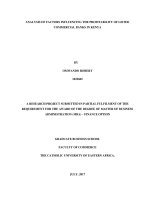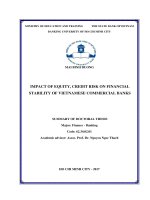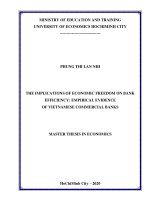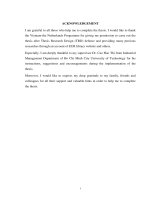The implication of economic freedom on bank efficiency an empirical evidence of vietnamese commercial banks
Bạn đang xem bản rút gọn của tài liệu. Xem và tải ngay bản đầy đủ của tài liệu tại đây (3.19 MB, 111 trang )
MINISTRY OF EDUCATION AND TRAINING
UNIVERSITY OF ECONOMICS HOCHIMINH CITY
-------------------------------
PHUNG THI LAN NHI
THE IMPLICATIONS OF ECONOMIC FREEDOM ON BANK
EFFICIENCY: EMPIRICAL EVIDENCE
OF VIETNAMESE COMMERCIAL BANKS
MASTER THESIS IN ECONOMICS
HoChiMinh City – 2020
MINISTRY OF EDUCATION AND TRAINING
UNIVERSITY OF ECONOMICS HOCHIMINH CITY
-------------------------------
PHUNG THI LAN NHI
THE IMPLICATIONS OF ECONOMIC FREEDOM ON BANK
EFFICIENCY: EMPIRICAL EVIDENCE
OF VIETNAMESE COMMERCIAL BANKS
Major: Banking and Finance
(Research Orientation)
Major code: 8340201
MASTER THESIS IN ECONOMICS
Supervisor: DR. LE DAT CHI
HoChiMinh City – 2020
DECLARATION
This is to certify that this thesis entitled: “the implication of economic freedom
on bank efficiency: an empirical evidence of Vietnamese commercial banks” which I
submitted to fulfill the requirements for the degree of master in finance. This thesis is
only my original work and due supervision as well as acknowledgment have been
made in the text to material used.
Ho Chi Minh City, 6th December 2019
Author
Phung Thi Lan Nhi
TABLE OF CONTENTS
DECLARATION
TABLE OF CONTENTS
ABBREVIATIONS
LIST OF TABLES
LIST OF FIGURES
ABSTRACT
CHAPTER 1: INTRODUCTION ................................................................................................... 1
1.1. Research objectives .............................................................................................................. 2
1.2. Research questions................................................................................................................ 2
1.3. Research scope and methods ................................................................................................ 3
1.4. Research Structure ................................................................................................................ 3
CHAPTER 2: LITERATURE REVIEW ........................................................................................ 4
2.1. Theoretical Literature ........................................................................................................... 4
2.1.1. Theory of economic freedom........................................................................................ 4
2.1.1.1. The concept of economic freedom ........................................................................ 4
2.1.1.2. Economic freedom Indicators................................................................................ 5
2.1.2. Theory of bank efficiency ............................................................................................. 9
2.1.2.1. The definition of Bank efficiency ......................................................................... 9
2.1.2.2. Bank efficiency - financial ratios approach .......................................................... 9
2.1.2.3. Bank efficiency - Production Possibility frontier (PPF) approach.................... 11
2.1.3. Economic freedom and bank efficiency..................................................................... 15
2.2. Empirical studies................................................................................................................. 17
2.2.1. Economic freedom ...................................................................................................... 17
2.2.2. Financial freedom ........................................................................................................ 20
2.2.3. Freedom from corruption ............................................................................................ 20
2.2.4. Government spending ................................................................................................. 22
2.2.5. Property rights ............................................................................................................. 22
2.2.6. Business freedom......................................................................................................... 23
2.3. Control variables ................................................................................................................. 24
2.3.1. Bank size ...................................................................................................................... 24
2.3.2. Equity/Assets (Bank capitalization) ........................................................................... 25
2.3.3. ROAE (Profitability) ................................................................................................... 26
2.3.4. Loans/ Total assets (Credit risk) ................................................................................. 26
CHAPTER 3: DATA AND METHODOLOGY .......................................................................... 28
3.1. Research method ................................................................................................................. 28
3.1.1. Data Envelopment Analysis (DEA) ........................................................................... 28
3.1.2. The bootstrap DEA method ........................................................................................ 30
3.2. Model specification ............................................................................................................ 32
3.3. Variables description .......................................................................................................... 34
3.3.1. Variables for DEA ....................................................................................................... 34
3.3.2. Variables for truncated regression .............................................................................. 36
3.3.2.1. Dependent variable............................................................................................... 36
3.3.2.2. Independent variables .......................................................................................... 36
3.4. Data source .......................................................................................................................... 41
CHAPTER 4: RESULTS AND DISCUSSION ........................................................................... 42
4.1. Descriptive statistics ........................................................................................................... 42
4.1.1. Efficiency estimates .................................................................................................... 42
4.1.2. Truncated regression estimates ................................................................................... 44
4.1.3. Vietnam economic freedom overview ....................................................................... 46
4.2. Correlation ........................................................................................................................... 48
4.3. Result ................................................................................................................................... 50
4.3.1. First stage result - Bank efficiency ............................................................................. 50
4.3.2. Second stage result - Truncated regression result ..................................................... 53
4.4. Sensitive Test ...................................................................................................................... 60
CHAPTER 5: CONCLUSION ...................................................................................................... 65
5.1. Conclusion and policy implication .................................................................................... 65
5.2. Limitation ............................................................................................................................ 66
REFERENCES
APPENDIX
ABBREVIATIONS
GCC
Gulf Cooperation Council
BE
Bank efficiency
EF
Economic freedom
FF
Financial freedom
PCBs
Private Commercial Banks
SOBs
State Owned Banks
SSA
Sub- Saharan African
TE
Technical efficiency
LIST OF TABLES
Table 3.1: The overview of input and output variables to estimate bank efficiency
scores (DEA) in first stage ............................................................................................. 35
Table 3.2: The overview of explanatory variables to regress in second stage ............... 40
Table 4.1: A summary statistics of variables used to estimate the bank efficiency (first
stage) in Vietnamese commercial banks from 2010 to 2018 ........................................ 42
Table 4.2: A summary statistics of variables used for truncated regression (second
stage) to investigate economic freedom effects on bank efficiency during period 20102018 ................................................................................................................................ 44
Table 4.3: Viet Nam economic freedom index 2010-2018 ............................................ 46
Table 4.4: Correlation matrix among variables in truncated regression ........................ 49
Table 4.5: Banking efficiency (TE) scores in the period 2009-2018 ............................. 50
Table 4.6: the distribution of Vietnamese bank Technical Efficiency scores 20102018 ............................................................................................................................... 53
Table 4.7: Second stage result - Truncated regression result ......................................... 53
Table 4.8: Merger and Acquisition in Viet Nam commercial banks 2012-2015 ........... 60
Table 4.9: Sensitive Test ................................................................................................ 61
Table 4.10: Summarize result between second step regression and sensitivity test ...... 64
LIST OF FIGURES
Figure 2.1: Technical efficiency (TE) - Allocative efficiency (AE) - Economic
efficiency (EE) ............................................................................................................... 12
Figure 2.2: Input- Oriented approach (IO) ..................................................................... 13
Figure 2.3: Output- Oriented approach (OO)................................................................ 14
Figure 3.1: Variable Returns to scale Model (VRS) and constant Returns to scale
Model (CRS) .................................................................................................................. 30
Figure 4.1: Graph of average efficiencies of Viet Nam banks 2010-2018 .................... 52
THE IMPLICATIONS OF ECONOMIC FREEDOM ON BANK EFFICIENCY:
AN EMPIRICAL EVIDENCE OF VIETNAMESE COMMERCIAL BANKS
Abstract
The effect of economic freedom on the economy’s well-being has been widely
documented. However, it is absent from the literature of empirical evidence about
effect of economic freedom on the banking sector. This study employs the overall
economic freedom index and the index’s components which are derived from Heritage
Foundation to examine their effect on Vietnamese commercial bank’s effieciency. In
first procedure, we obtain efficiency scores of 39 banks in Viet Nam using Data
Envelopment Analysis (DEA), over the period 2010-2018 with 299 observations. Then
second step, the efficiency scores estimated from DEA method will be regressed on
economic freedom indexes, applying truncated regression model combined with
bootstrapped confidence intervals while controlling for bank specific characteristics.
Additionally, we carry out a sensitive analysis using a fractional logit estimator as a
robustness check.
We find strong evidence supporting that far greater economic freedom positively
impacts the efficiency of banks in Vietnamese banking sector. However, the influence
of different economic freedom counterparts on efficiency banking sector is not as
uniform as economic freedom overall index such as the higher the degree of property
rights, business freedom and freedom from corruption, the better the bank’s
performance while negative effects of financial freedom on bank efficiency. Besides,
the empirical findings also show the positive relationship between capitalization and
bank efficiency as well as credit risk and bank efficiency
Keywords: Banks, economic freedom, bank efficiency, DEA, truncated regression
bootstrap, Viet Nam
1
CHAPTER 1: INTRODUCTION
Efficiency is the most important aim of most business including banks, and bank
efficiency is a widely discussed topic because of its vital roles in creating a stable and
profitable banking sector then impact on economic growth in each country. As a
perspective that individual’s liberty to pursue its own economic goals will lead to
efficient outcomes is as instinctive as the economics theory itself, we have seen that
most countries trying to close to economic freedom. However, most of studies recently
just focus on the relationship between economic freedom (EF) and economic growth,
less studies have been carried about effect of economic freedom on banking sector,
which is one of the most important financial intermediary playing an important role in
providing funding sources for economic growth (Ferreira,2015). EF plays a vital role
for the banking sector’s development which categorizes of priority for developing
nations and improving efficient banking system in a globalized economy. Theoretically
argued, EF helps to motivate the environment leading to efficiency financial system’s
establishment or being innovative ideas and producing capacities, but the relationship
between EF and financial activities still remains vague (Terpilih, 2010).
For example, one of component in economic freedom is financial freedom, and
the effect of financial freedom (FF) in emerging markets of financial markets is not
easily determined as it relies on kind of reform and conditions of financial constrains in
the market (Ağca et al., 2007). As a study from Kose et al., (2003), the influence of FF
and integration on banking sector and economic growth is hard to determine because it
could rely on the governance’s quality and institutions. They points that the integration
in developing countries is lack of experience, and government could create higher
uncertainty shocks to banking sector resulting in lower efficiency. Lou et al., (2016)
find that the openness with high level leads to shrink of bank performance due to the
lack of technologies, skills, the high level of competition and knowledge. Higher
freedom and openness also lead to the higher dependence on each others and fragility
of banking sectors in the world such as credit risk, economic and information shock
(Anginer and Demirguc-Kunt,2014), which can affect bank efficiency ( BE).
2
On the other hand, Asharf (2017) finds that freedom increases the bank’s
development levels by decreasing cost and bank credit risk. The author also finds that
freedom helps to remove barriers of trading and stimulate lending diversification which
creates more bank credit demand and banks’ chances to growth. Reducing restrictions
in banking activities due to FF provides more potential chances to improve BE and
profitability (Chen, 2009). Banks tend to have higher profitability, efficiency in
countries that have high economic and freedom (Tennant and Sutherland 2014). A
study from Ahamed (2017) also shows that foreign Banks’s entry following freedom
policies will improve the host country’s banking system because of the “technology
spillover” effects which positively impact on the financial institution’s performance.
In Viet Nam, particularly this time, the Association of Southeast Asian Nations
(ASEAN) banking system has been preparation for the multilateral- liberalization
before of the year 2020 and this is basing on the ASEAN Banking Integration
Framework (ABIF) in 2014. Therefore, we expect Vietnamese banking system to
achieve higher liberalization, freedom and integration level in 2020. This keys on that
the importance to understand the impact of EF on BE to have appropriate actions for
the aim of maintaining stable and efficient banking system for economic development
in the long term.
This study follows this spirit by examining the impact of economic freedom on
the efficiency of Vietnamese commercial banks during the period of 2010 to 2018
1.1. Research objectives
- This study measures commercial bank’s efficiency in Viet Nam during the period of
2010-2018
- This study investigates the effects of economic freedom on banking efficiency in Viet
Nam during the period of 2010-2018
1.2. Research questions
To determine the impact of economic freedom on bank’s efficiency, this study
particularly aims to answer the following questions:
3
-
How are the Vietnamese commercial bank’s efficiency scores between 2010 and
2018?
-
Whether and how economic freedom affects on bank’s efficiency?
1.3. Research scope and methods
The data sample of this study includes 39 commercial banks in Viet Nam
between 2010 and 2018. They are both listed and unlisted banks. This study employs
quantitative analysis method with using a two-step approach:
-
First step: Estimation of efficiency scores by using DEA (Data envelopment
analysis), these efficiency scores are measured by technical efficiency (TE)
- Second step: Bank efficiency scores are regressed against an array of economic
freedom variables and other bank specific factors in truncated regression model
combined with bootstrapped confidence intervals
The data is unbalanced over 9 years examining: the dependent variable is
bank’s efficiency which is measure by Technical efficiency (TE) with DEA method,
and independent variables are bank specific factors and economic freedom indexes
derived from The Heritage Foundation 2018.
1.4. Research Structure
The study contains five chapters:
Chapter 1: Introduction
Chapter 2: Literature Review
Chapter 3: Data and Methodology
Chapter 4: Result and Discussion
Chapter 5: Conclusion
4
CHAPTER 2: LITERATURE REVIEW
This chapter provides theories about economic freedom and bank efficiency as
well as previous researches the relationship between them.
2.1. Theoretical Literature
2.1.1. Theory of economic freedom
2.1.1.1. The concept of economic freedom
Freedom (Liberalization) thinking and capitalism ideal have been generated
since classical economics like Adam smith, John Locke and recently Milton Friedman.
Since Adam smith, economists have believed that freedom to choose demand and
supply, competitive in business and trade with other countries and ensure the property
right which is essential components for economic advances (North and Thormas,
1973). Moreover, Adam Smith, in the book “ The wealth of Nations”, who had
emphasized that the invisible hand role in a free market to help an economy
comparatively work and function well , then increasingly wealth of nations. Milton
Friedman (1962) said “I believe that freedom society exists because of economic
freedom bringing more efficiency than other solutions in controlling economic
activities”
Hayek foresaw decades ago in the book the road to Serfdom:“the guiding
principle in any attempt to create a world of free man must be this: a policy of freedom
for the individual is the only truly progressive policy” (F.A.Hayek, 1944).
Furthermore, in “ The constitution of Liberty “ (1960) of Friedrich Hayek, he analyses
that economic freedom should be understood as freedom under government’s law, and
freedom does not mean that absence of all government actions. Therefore, economic
freedom is not an absolute freedom, whereas government actions must have. Freedom
requires forces, violence and fraudulent to be prevented, except using government
forces to make sure best situations with aim for individual efficiency. If the
government’s coercion is exceed limits, economic freedom will be hurt.
5
In The Heritage Foundation 2014 “A comprehensive view of economic freedom
encompasses all liberties and rights of production, distribution, or consumption of
goods and services. The highest forms of economic freedom should provide an
absolute right of property ownership; full freedom of movement for labor, capital and
good; and an absolute absence of coercion or constraint of economic activity beyond
that which is necessary for the protection and maintenance of liberty itself. Individuals
are free to work, produce, consume, and invest in any way they choose under the evenhanded application of laws, with their economic freedoms at once both protected and
respected by the state”. According to Gwartney and Lawson 2002, EF means the extent
to which a market economy is in place, where the central components are voluntary
exchange, free competition and protection of person and property.
In conclusion, following The Heritage Foundation (2014): “economic freedom
is the condition in which individual can act with maximum autonomy and minimum
obstruction in the pursuit of their economic livelihood and greater prosperity. However,
the goal of economic freedom is not simply an absence of government coercion or
constraint, but the creation and maintenance of a mutual sense of liberty for all. As
individuals enjoy the blessings of economic freedom, they in turn have a responsibility
to respect the economic rights and freedoms of others within the rule of law.
Governments are instituted to ensure basic protections of one citizen over another.
Positive economic rights such as property and contracts are given societal as well as
individual defense again the destructive tendencies of others. At the end, economic
freedom enhanced and secured by the rule of law, government size, regulatory
efficiency, and market openness, is a vital element of human dignity, enabling
individuals plan and direct their lives in ways that maximize their happiness as they see
fit. Therefore, economic freedom is the key to achieve the broad-based economic
dynamic that ensures lasting growth and increases prosperity for society as a whole”.
2.1.1.2. Economic freedom Indicators
There are four indicators of economic freedom: The Fraser Institute, The
Heritage Foundation, Freedom house, and Scully & Slottje (1991). They differ in the
6
methodswhich they have been constructed, and purposes and the conception of
economic freedom embodying. The first two Indicators (Fraser Instituteand The
Heritage Foundation) have been using up to now.
The Fraser Institute: This indicator was produced by Hames Gwartney and Robert
Lawson, and it has been more widely used than any measures of economic freedom.
It covers the time period data from 1980 to 2008. It is different with the index
created by the Heritage Foundation that is constructed by third party information.
The cornerstones of economic freedom include personal choice, voluntary exchange,
freedom to compete and security of privately owned property. In fact, the index
measures : Size of government ( expenditures, taxes, and enterprises); Legal
structure and security of property rights; access to sound money; freedom to trade
internationally; regulation of credit, labor and business
Freedom House: First published in 1996 of economic freedom, but then this
publication has been discontinued. They defined economic freedom through two
different dimensions: lack of state infringements on citizen’s right to exchange
goods and services, and the second one is the state establishmentof the rules
governing contracts, property rights and other institutional prerequisites required for
the product of economic affairs. The Freedom house includes six indices (freedom
to hold property, freedom to earn a living, freedom to operate a business, freedom to
invest one’s earnings, freedom to trade internationally and freedom to participate in
the market economy)
Scully and Slottje (1991): This was an effort to build the first measures of Freedom
House. This data is only available in 1980, including 141 countries and having
fifteen different characteristics: exchange rate system freedom, freedom from
military draft, property freedom, movement freedom, information freedom, civil
freedom index of Gastil, classify Gastil – Wright for economy system, printing and
press freedom, broadcast freedom, freedom to travel inside, freedom to travel
outside, peace freedom, working permit freedom, freedom to seek without
permission, freedom to hold real estate.
7
The Heritage Foundation: This index is a series of twelveeconomic measurements
produced by the Heritage Foundation and Wall street Journal. This index has an
advantage like The Fraser Institute as continuous data, and this has been constructed
since 1995, including 161 countries and public every year. The Index of economic
freedom takes a broad and comprehensive view of a country performance,
measuring twelve separate areas of economic freedom. Some of the aspects of
economic freedom are concerned with a country’s interactions with the rest of the
world such the extent of an economy’s openness and trade. However, mostly
assessing the liberty of individuals to use their labor or finances without undue
restraint and government interference. Each of the economic freedom plays a vital
role in developing and sustaining personal and national prosperity. Every economic
freedom is individually scored on a scale of 0 to 100. An overall economic freedom
score is a simply average of its scores on the twelve individual freedoms. For
presentational clarity, the twelve economic freedoms are classified into four widely
categories: Rule of law (property rights; freedom from corruption; judicial
effectiveness); Government size (fiscal freedom, government spending; tax);
Regulatory efficiency (business freedom, labor freedom, monetary freedom); Market
openness (trade freedom, investment freedom, financial freedom). Besides the
overall economic freedom index, we have selected these indicators below (in four
categories above) which are closely related to the banking sector in order to carry on
this study.
-
Financial Freedom: The index is a measure of banking security as well as
independence from government control. Being to access and function well in a
formal financial system that ensures the availability of payment and investment
services to individuals, diversified savings, credit.By extending financing
chances and promotingentrepreneurship, an open banking environment
encourages competition to bring the most efficient financial intermediation.
Banking and financial regulators by the state that is over the assurance of
transparency and honesty in financial markets can decrease efficiency.
8
-
Government spending: The cost of excessive government is a central issue in
economic freedom. Excessive government spending eventually will be financed
by higher taxationor run a great risk of crowding out private economic activity.
Even worse, a government’s insulation from market discipline often leads to
bureaucracy; lower productivity and inefficiency then undermine economic
freedom.
-
Property rights: The ability to accumulate private property and wealth is
understood to be a central motivating force for workers and investors in a
market economy. The protection of private property requires and judicial system
that is available to all equally and without discrimination. And the transparency
and effectiveness of the judicial system have proven to be key determinants of a
country’s prospects for long term economic growth.
-
Freedom from corruption: In the perspective of EF, corruption can be expressed
as the integrity’s failure in the economic system or a distortion when special
groups or individuals are able to take at the expenses of the whole. Then a
country imposes numerous burdensome barriers on conducting business, higher
transaction costs or bribery.
-
Business freedom: this index expresses the degree of freedom of entrepreneurs
are able to start businesses or in order to obtain licenses and the ease for closing
a business. Obstacles to any of these three activities are able to be deterrents to
business and then to job creation.
Accordingly to many studies, the best indicator is Heritage Foundation because
it has been mostly based on the policies which governments can control actually
(Heckelman, 2000). On the other hand, the index by Fraser institute is mostly
ambiguous efforts to measure economic freedom, and updating by each five years will
be hard to consider economy measurement in short term. In this study, we consider
economic freedom index provided by Heritage Foundation which is updated by every
year.
9
2.1.2. Theory of bank efficiency
2.1.2.1. The definition of Bank efficiency
The definition of efficiency in general or particularly BE are common terms in
the literature of economic discipline. Productivity and efficiency are normally used for
each other. In economics, a firm is considered efficient if it can maximize its output
using a given certain inputs, or it reaches the Pareto optimal. (Pareto efficiency as a
measure of social welfare is used by many scholars as their efficiency goal. A situation
is optimal only if no individuals can be made better off without making someone else
worse off).
An economic system is said to be more efficient than another (in relative terms)
if it can provide more goods and services for society without using more resources. Or
we can consider total factor productivity (TFP) which is productivity estimation
including all factors of production, mean efficiency can be seemed as productivity and
be measured by the ratio output/input
Productivity (Efficiency) =
𝑂𝑢𝑡𝑝𝑢𝑡
𝐼𝑛𝑝𝑢𝑡
Out: such as revenues, profit …
In: costs, fixed assets,
Efficiency is one kind of economy perspective, it has been measured by
comparing between the actual values and optimal value of cost, revenues and profit or
any expenses which a firm pursues (Daraio and Simar, 2007).
In general terms, for the definition of efficiency in banking sector, a bank could
be called as efficient only if it is able to produce an expected result with a minimum
provided effort of resources.
In particularly, there are two approaches to measure the bank efficiency –
Financial ratio and production possibility frontier (PPF)
2.1.2.2. Bank efficiency - financial ratios approach
The approach from financial ratio can be understood as measuring bank
efficiency from financial ratios which are counted from financial statements. In
10
banking sector, many researchers measured operating efficiency ratio by counting
percentage between overhead to total assets. The lower ratio is the higher efficiency of
the bank. Nowadays, the operating efficiency ratio accordingly to international
standard is 0.6, this means any banks which has below this ratio, will be efficient
operating and vice versa. Besides, other financial ratios has been preferred such as
ROA, ROE (Chen and Liao, 2009)
In common, there can be considered into four groups of financial ratios to
measure bank efficiency: Profitability rates (ROA, ROE, ROS, C/I), margin rates(Net
interest margin), weighted result rates, employment efficiency rates
Profitability rates
- ROA: (The rate of Return on Assets): is a ratio to measure the ability of
management to utilize the actual financial resources of a bank to create
returns. This ratio is widely used to evaluate bank’s performance
- ROE: ( The rate of Return on Equity) is a ratio of financial result to a bank’s
owner fund
- ROS: (The rate of Return on Sales): is a ratio of financial result to a bank’s
income.
- C/I: ( Costs ratio to incomes)
Margin rates
- Net interest margin: a ratio of interest to assets, and interest spread which can
be understood as a difference between the average interest bearing assets and
the average expenses of interest bearing liabilities.
Weight result rates: reserves balance which is shown as a difference between the
building up and dissolution of reserves.
Employment efficiency rates
- Assets/ Number of employees
- Result/ Number of employees
Based on analyzing financial ratios and comparing with other banks and time
varying, we conclude about the bank efficiency. However, this approach has few
11
drawbacks, such as financial ratios have to be compared with a consensus standard,
while constructing this standard is hard. Or different financial ratios has different
conclusion about efficiency, perhaps this bank can be concluded that efficiency using
ROA whereas inefficiency in capital (Chen and Liao, 2009)
2.1.2.3. Bank efficiency - Production Possibility frontier (PPF) approach
However, in the production economics, the definitions of efficiency and
productivity are two different concepts. While the “productivity” is considered as the
entire elements that decide the output’s level achieved with the input provided,
efficiency has a different meaning in comparison with productivity.
Efficiency has been approached by the production frontier, which shows
output’s level which can be reached a peak with the same level of input’s level. That is
clarified as the ideal relationship between input and output, related to a process to gain
the greatest level of outputs with lowest input’s level. And the company producing on
this frontier definitely will be seemed as efficiency. There is inefficient producing if
this is below the frontier and further distance, more inefficiency it is.
In 1957 Farrell took the efficiency’s measurement into the higher degree by
establishing the functions of distance between efficiency and producing practically
point. Academically, he is remembered largely for the celebrated non- parametric
measure of productive efficiency.
There are three kinds of efficiency: Technical efficiency – TE; allocative
efficiency –AE; economic efficiency- EE
TE: The ability of a firm to obtain maximal output from a given set of inputs (Inputorientation) or the ability of a firm to minimize input from a given set of outputs
(Output-orientation).
AE: the ability of a firm to use the inputs in optimal proportions, given their prices and
can be defined as an optimal utilization for the cost minimizing combination of inputs
EE: AE multiply with TE expressing the overall efficiency of the company – Economic
efficiency
EE= TE*AE
12
Assume a model with 2 inputs (x1 and x2) and 1 output (q) as the figure below
Figure 2.1: Technical efficiency (TE) - Allocative efficiency (AE) - Economic
efficiency (EE)
TE = 0Q/0P
AE = 0R/0Q
EE= 0R/0P
The figure above demonstrates three kinds of efficiency with input orientation. Where:
SS’: Technical efficiency frontier
AA’: Cost line
The TE measured 0Q/0P must lay between 0 and 1, at the value of one means
that the firm is fully efficient. Reduction in cost if production is at Q’, so at the point Q
the TE firm is efficient but AE is inefficient. The economic efficiency EE = TE*AE (or
equal to 0R/0P)
Furthermore, the PPF’s theory can be processed with two approaches: InputOriented approach and Out-put- Oriented approach .The firm with IO is to measure the
lowest input’s amount to create a given set of outputs, whereas OO one is in order to
predict the maximum output’s level from a provided input’s level.
Input- Oriented approach (IO):
13
Below Figure 2 illustrates a company with x1 and x2 (2 inputs), and 1 output y ,
SS’ is a frontier which demonstrates each input’s lowest level that can be used to create
a provided output (Technical efficiency frontier). If a company works on this frontier,
it will be technical efficiency in an input-oriented one because of minimizing the
input’s amount. The frontier AA’ (cost line) (which can be built when we already know
the input-price ratio) defines the optimal input’s level to archive the lowest cost.
Figure 2.2: Input- Oriented approach (IO)
TE = 0Q/0P
AE = 0R/0Q
EE= 0R/0P
The distance RQ’ can be interpreted in terms of cost reduction. Then the
multiply of technical and allocative one is overall economic efficiency. All of three
measures are bounded between zero and one.
Out-put- Oriented approach(OO) :
Figure 3 demonstrates that the case in which a company has one input (x) and
two outputs (y1, y2). The ZZ’ curve defines that the highest output level can be
reached by using given input’s level x (Technical efficiency frontier). The company is
TE only if it works on this frontier. DD’ is the price information. The distance CB’ can
be interpreted in terms of cost reduction.
14
There measures in this case also are bounded by zero and one.
Figure 2.3: Output- Oriented approach (OO)
TE = 0A/0B
AE = 0B/0C
EE= 0A/0C = TE*AE
There are exceptional ones by applying both sides (Beccalli et al., 2006) and not
consensus on the proper results of IO and OO in BE measurement up to now.
Actually, the foundation of theories about efficiency and BE has been established well
long time ago and attracted a variety of academic researches carried on such Berger
and Deyoung (1997) with different method of evaluation.
Inclusion, efficiency concepts are various and diversified, depending on which
purpose we can consider as different perspectives. However in this study, Technical
Efficiency (EF) is used to measure BE. (TE) of bank that focuses on the ability of bank
to reach outcomes with minimum set of inputs. To reach the desired output, we make
an effort to minimize the inputs, and then the technological innovations in the banking
industry will be reflected on the production frontier. That means if a bank operates on
this frontier, this could be considered as technically efficient (TE). And further
distance, more inefficient the banks are. Besides, we apply efficiency with inputorientation because it seems that IO method is almost preferred to the OO as banks can
15
focus on managing the input level
(costs) ,better than basing on the outputs
level.(Dipasha et al., 2012). The measurements and analysis of TE are conducted by
Data Envelopment Analysis (DEA), the next section methodology will discuss further.
2.1.3. Economic freedom and bank efficiency
This section lays out the relevant theories as well as literatures on BE and EF
related to financial sector performance, while we derive the hypotheses below.
In fact, there are no existing models of theory to analyze explicitly the impact of
EF on BE developed yet, while as far as we have known that few related economic
theories are likely to have impact on the banking sector:
- Classical economics theory: Classical economics is a broad term that refers to
the dominant school of thought for economics in the 18th and 19th centuries. Mostly
considering Scottish economist Adam Smith is the progenitor of the classical economic
theory. Adam Smith (1776) release of the Wealth of Nations highlights some of the
most prominent developments in classical economics. His revelations centered
surrounding free trade and a concept called the "invisible hand" which served as the
theory for the beginning stages of domestic and international supply and demand. Selfregulating democracies and capitalistic market developments form the basis for
classical economics. The classical economists were pragmatic liberals (economic
liberalism), advocating freedom of the market, though they saw a role for the state in
providing for the common good. Smith acknowledged that there were areas where the
market is not the best way to serve the common interest, and he took it as a given that
the greater proportion of the costs supporting the common good should be borne by
those best able to afford them. He warned repeatedly of the dangers of monopoly, and
stressed the importance of competition. To be related to banking sector, an
environment of banking and finance in which a lowest government’s level interference
and less dependent on central bank as well as financial institutions supervision;
especially regulations are limited to enforce contractual obligations and prevent from
fraudulence, this will improve bank efficiency.
16
- Economic theory: Suggestions from Economic theories that EF tends to affect
productive encourages, efforts, and the resource using’s effectiveness. Arguments from
economic historians that the central components for economic growth are free to
supply or choose resources, trade freedom with others, competing in business and
ensure property rights (North and Thomas 1976). In addition, the intuitional issues like
lacking investment or weak systems to protect property right and avoid corruption go
on defeating the total EF and economic potential (North and Thomas, 1976), so it is
easy to link with the relationship between bank performance and economic freedom
under economic theory. This can be indicated that a link EF and BE, in particular, the
higher the level of EF, the bank’s benefit in terms cost advantages and overall
efficiency.
- Helping hands (Pigou, 1938): However, another theory considers the role of
supervision and less freedom as an appropriate policy such helping hands. The helping
hand theory implies that a government’s helping hand will be strong and effective to
offset or even ameliorate the failures of market in case of external power, monopoly
power and informational asymmetries. In banking perspective, this role of government
seems as a bank’s official supervision to limit on bank’s activities as well as restrict on
bank entries and insurance of bank deposit scheme as proper policies that alleviate
failures of market or help to allocate resources (Barth at al., 2006). This can make bank
efficient as much as possible to their roles.
- The theory of property rights: Coase (1937); Alchian (1969); Demsetz
(1967) are pioneers for this theory. Basing on encourages to direct individuals and
organization’s economic behavior, an investor has ability to take return of most
efficient choices, then he or she can consider and take each alternative choices,
compared with net gain among each choice alternative one. Finally, choosing a choice
in which can produce the highest benefit for her. Obviously, this makes the economy
operating efficiently. The incentives behind that direct behavior of investor are based
on property rights of the investor’s decision. Property rights theory carries on the
impact of right assignments on investor’s decision by allocating resources and
efficiency. This analysis is assumed in the terms of efficient market’s neoclassical
17
model in which this does not have information issues; zero transaction cost and agent
behavior is perfect to maximize the profit from all participants existing in the market
(Furubotn & Pejovich, 1972). Besides, each investor who has this right will employs
these rights to gain its wealth. By implication in banking sector, such protection
provides incentive for borrowers and lenders, and decreases protection costs as well as
ensures property rights, then borrowers, investor and lenders can devote fewer
resources with no hesitant.
2.2. Empirical studies
2.2.1. Economic freedom
a) Supporting evidences:
With the basic tenets of economic theory, the relationship between economic
freedom and bank efficiency is clearly understand : higher degree of freedom, higher
level of efficiency as the less constraints to manage their company in controlling cost,
thus business will be more effective. Therefore, we also have many studies support for
this ideal. For example, Chortareas (2013) investigated the relationship between
financial freedom counterparts or economic freedom index and bank efficiency. This
economic freedom had been drawn from the Heritage Foundation database and the
sample of commercial banks with 27 European Union member countries collected from
2001 to 2009. The author uses the DEA method to estimate technical efficiency scores
of banks in the first stage, then second stage using truncated regression model
combined with bootstrapped to regress the efficiency scores with economic freedom
variables. This paper finds that a positive significance effects of economic freedom on
bank efficiency in term of cost advantages: higher the level of an economy’s financial,
higher the benefits for banks. Especially, it tends to be clearer in which countries with
more freedom political systems and governments with higher quality governance.
Investigating the effects of low-liberalized policies on banks, Sun and Chang (2011)
find that if the openness is lower degree, it can go up the liquidation costs or switching
costs which may seriously decrease bank performance and get case of bank’s loss.
Bank can improve the profit efficiency as a result of the liberalization of Technology

